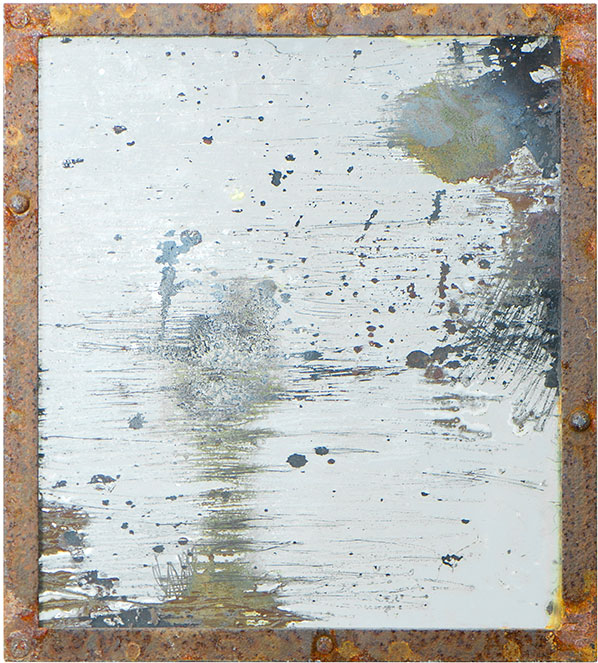 An artist's biography somehow eventually influences his or her works, which is what naturally and invariably happens for all creative processes. It is actually impossible for our psychological and emotional life experience not to leave clear marks on the creation of images which, after all, are the result of the projection of any individual being and of their peculiar way of processing and representing reality. An artist's biography somehow eventually influences his or her works, which is what naturally and invariably happens for all creative processes. It is actually impossible for our psychological and emotional life experience not to leave clear marks on the creation of images which, after all, are the result of the projection of any individual being and of their peculiar way of processing and representing reality.
As for Brigitta Rossetti, the autobiographical tendency is an essential element of her artistic creativity. It is a necessary, although not sufficient condition, to explain the branching off of her visual thoughts.
The writer and poet Rainer Maria Rilke claimed that “Works of art are of an infinite solitude, and no means of approach is so useless as criticism”. Such a statement is particularly relevant when we consider the output of an artist withdrawn into his/her own shell and reluctant to come to terms with the expectations and pressures of the surrounding society.
Unlike any such artist, Brigitta Rossetti has developed a marked sensitivity towards contemporary society and, especially in the past few years, she has been trying to find a way to let her personal experience be tuned within the wider context of general matters. Through her works she has painstakingly endeavoured to investigate the complex relationship existing between man and the environment which, incidentally, seems to be on the verge of a dangerous condition of deterioration and imbalance. Brigitta Rossetti's approach actually develops out of a mere biographical event: her studio is situated inside a former hayloft which has been turned into a residence at the heart of the countryside in the province of Piacenza.
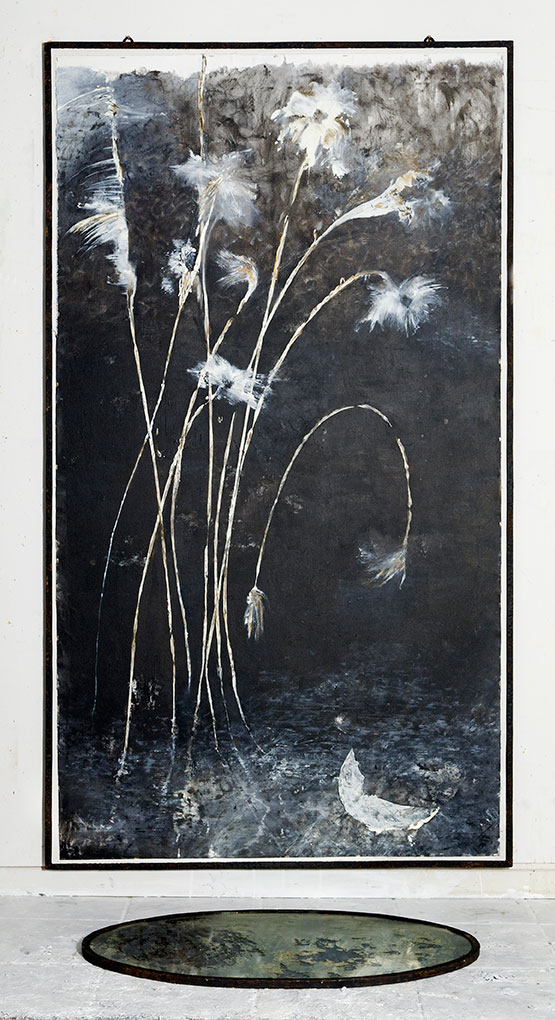
The landscape, therefore, with its endless variety of shapes and hues, provides a natural setting for the artist's aesthetic reflections. What she can see day by day is not just what influences her perception of reality, but it also forcefully pours into her artistic technique, which resorts to the use of organic matter, of salvaged artifacts and household objects.
Actually, Ms Rossetti's research originates from the combination of the matter-of-fact simplicity of daily life with its unsophisticated gestures, habits and tools, with the lyrical and titanic prospect of reconstructing the fundamental human values within the frame of a society that seems to be speedily heading towards the opposite destination of natural order.
What characterises her works, based on various means and media and ranging from painting to sculpture, from artistic installations to videos, is the use of retrieval materials such as pieces of wood, old ladders, mirrors, printed pages from books, chairs, as well as such organic matter as earth, stones, logs and leaves, which recall an immediate link with nature.
Despite the close resemblance to the tenets of the Arte Povera movement concerning the use of elements from the landscape, Brigitta Rossetti's works are above all characterised by a lyrical, elegiac inspiration, influenced by the rhythms and inflection of poetry as well as by a romantic cluster of imagery indeterminately suspended between the appeal of abstract art and the allure of symbolism.
It is painting, with frequent contaminations from sculpture and artistic installations aimed at widening its expressive potential in a three-dimensional, environmental-friendly perspective, that constitutes the leading thread of the artist's research. Those paintings are, however, distant from descriptive, camouflage stylistic features but are rather constructed to start from the idea of a progressive stratification of signs and gestures aimed at faithfully recording the process of metabolic fusion of inner and outward reality, of observation of phenomena and emotional experience. That is the key to fully understand the implications of Brigitta Rossetti's works. In many of her compositions the painting technique is combined with ready-made materials in order to create an oleographic fragment of the natural world, which is capable of including both a fanciful projection of the environment and its physical, concrete reconstruction.
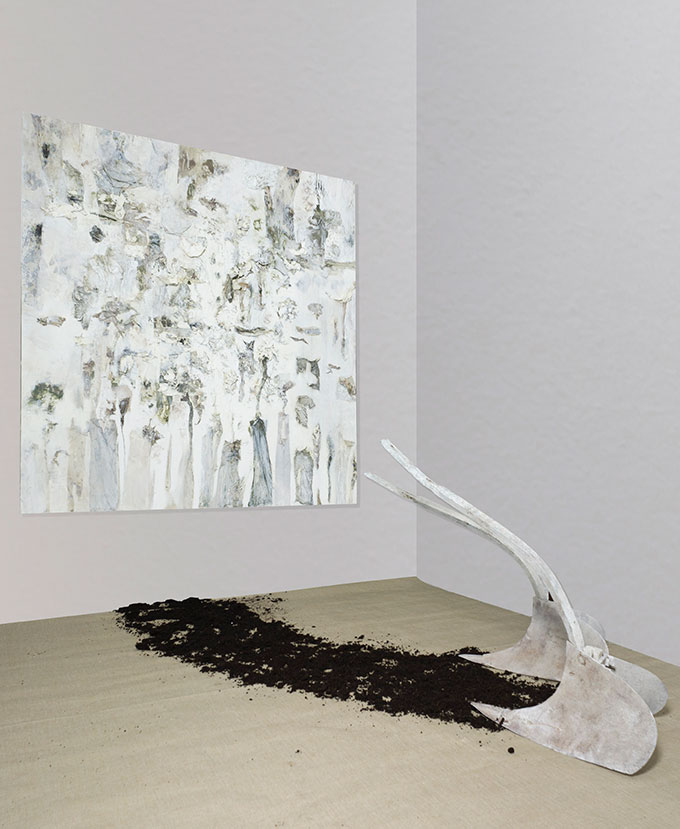
Campo arato (The ploughed field), for instance, is an installation including a pictorial work made with kitchen paper, acrylic paints and pigments as well as an object trouvé and an organic element. A fragrant streak of dark earth links the canvas to two small white painted ploughs, thus producing a sort of three-dimensional allegory of the creation.
The canvas represents the untended field to be metaphorically ploughed by the artist with the tools of technique and imagination.
A similar modus operandi can be spotted in the Paesaggio quasi bianco (Virtually white landscape), consisting of a painting set on top of an old wooden ladder which gives the illusion of looking at a snow-capped view through a dormer or attic window.
The painting becomes once again the object of a personal journey of discovery, the revelation of an unexpected event. It is not by chance that Brigitta Rossetti considers art in general, and painting in particular, not just as the result of a predetermined project, but rather as a wandering course where surprises and unexpected discoveries are likely to occur.
Many solutions chosen by the artist are actually the consequence of a series of intuitions that come to light when the works are in progress, just when the original idea and project are aided by flashes of inspiration and by the strokes of practical skill. Such sudden inspiration may be kindled by the recovery of special objects or the recycling of waste materials that acquire fresh, new life for the artist.
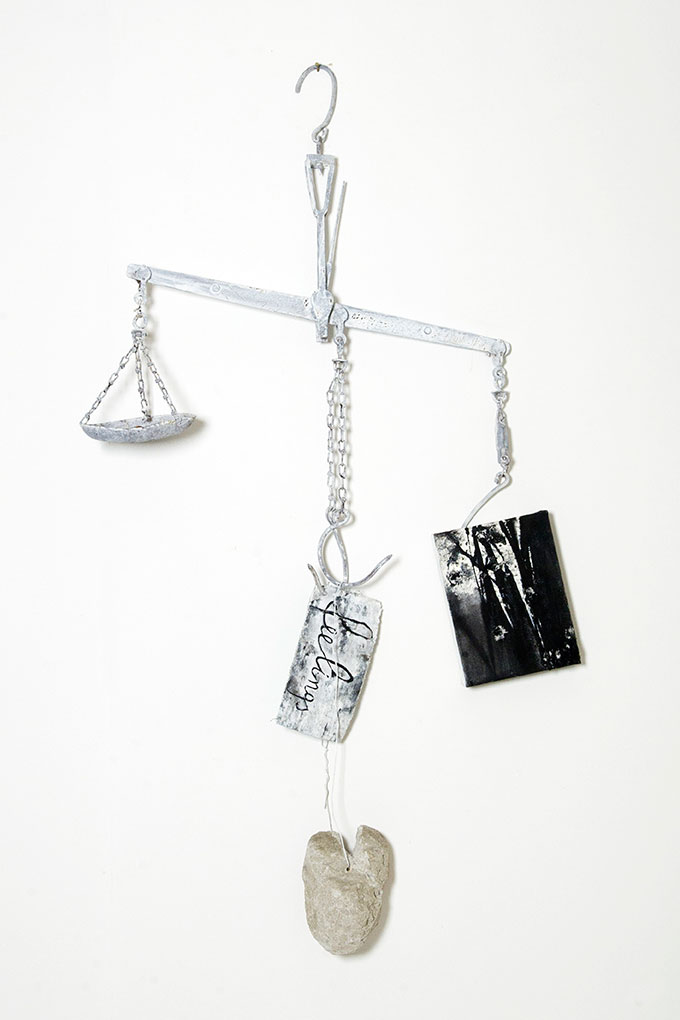
In the works entitled Cielo e non altro (Nothing but sky) and Ave Maria (Hail Mary) the kitchen paper is used to turn the painting surface into crêpe paper and create a mixture of colours and pigments that shatters the traditional two-dimensional boundaries of painting.
However, in Sogni di Pietra (Stone Dreams), a wall installation with twenty-two small-size paintings, the ready-made has a prominent ecological connotation. The props on which Rossetti outlines her fragments of landscape are special pads generally used to soak up toxic sewage. It is as by a sort of alchemic process that the artist turns poisonous waste which would require very special disposal into an aesthetic artifact meant to inspire a message of hope. The theme of reconciliation with nature actually underpins all the artistic creation of Ms Rossetti.
This is particularly true if we think of her Children's Garden or of the Reflection series, where the representation of huge, imaginary flowers is a sort of invitation to reflect on the fragility and uncertainty of natural stability. In both series the paintings are combined with retrieval materials such as children's chairs and old mirrors, which are meant to provide a background context for the visionary painting.
In Children’s Garden nature is considered an inspirational place for children, whom it can help develop a civil and moral conscience, whereas in Reflection nature is seen as a space inspiring contemplation. When mirrored in the metaphorical water puddle set at the foot of the painting, the spectators acquire awareness of belonging to the same environment that they so unwittingly contribute to destroy. This is in full contrast with the myth of Narcissus, i.e. the condemnation of the terrible consequences that the ecosystem is bound to suffer because of man's unbounded selfishness, which we can also find in the alienating sequence of reflective surfaces of Mirrors.

Crossing is an artistic achievement which clearly mirrors the imbalance of contemporary civilization. It is an installation consisting of two distinct elements: a wall sculpture made with cardboard tubes bound to be dumped and the projection of a video shot in the streets of Taiwan. The organ, with its reference to the tradition of sacred music, is a remainder of the sounds that usually accompany prayer and contemplation and also revives the memory of the slowly paced ancestral life. “It is the silence of the wide spaces of the countryside that surrounds me”, Brigitta Rossetti explains, “which revives age-old traditions such as the evening tales, the prayers around a chapel, the blessings of ground, sun and rain...such memories lead me to add flowers, leaves, logs, butterflies and other organic matter to my material natural works”.
The glittering surface of the organ pipes with its folds and projections mirrors the images of just one day of ordinary hysteria in an Asian megalopolis, crowded with passers-by who wear smog masks while crossing a crammed, noisy city crossroads. The vision of such a daily hell, where nature seems to have lost all of its power, is superimposed by mnestic traces of the good old days not yet spoilt by the spiritual crisis of our contemporary age. In Brigitta Rossetti's work both realities are fused and become a single entity where present and past coexist at the same time. Crossing is a contradictory work, a sort of Taoist oxymoron which points at the intrinsic mingling of constructive and destructive forces that liven up an anthropic conception of the universe. This is right the opposite principle inpired by the work entitled Sempre dritto, avanti, gira a destra (Go ahead, straight on, turn right) which is a reference to man's creative potential and power of modifying reality through our thoughts.
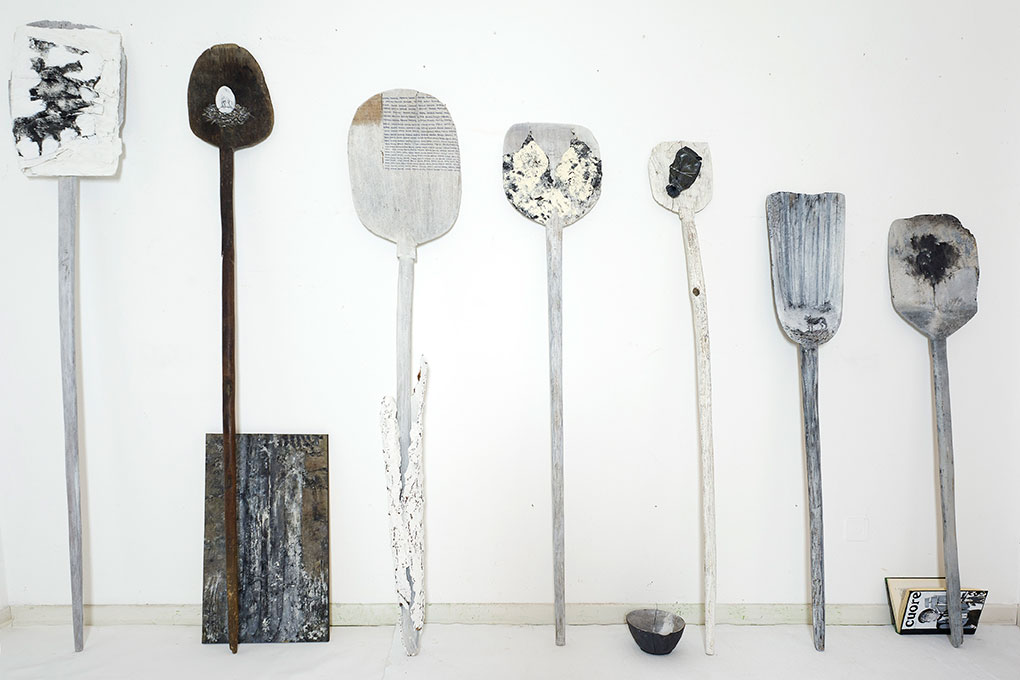
For this installation the artist retrieved seven old round sieves and painted each one with a plethora of imaginary planets, such as Planet Raimbow, Planet Lone Tree, or even Planet Hibernation. As in many other works the artist's constructive attitude and capacity of nourishing feelings of hope and gratitude towards the universe is clearly expressed in this installation. In Seven Days of Thanksgiving the number seven, symbol of human nature perfecting and of the totality of the created universe (3 days for the sky and four days for the earth). The seven peels painted in acrylic and mixed technique and lined up in upward order represent a sort of personal, votive home altar devoted to nature and the animal world, as well as to childhood memories, to music and to the tales and stories that brighten up our existence.
To sum up, Effetti personali (Personal belongings) seems to epitomise all the different facets of Brigitta Rossetti's artistic research, but it also most probably represents the story of a spiritual and aesthetic training watched over by the everlasting shield of nature. It is a heart-broken, attentive declaration of the present hardship of human nature yet brightened by a glimmer of hope and the omen of a better future. Even in our dark age Lord Byron' immortal verse still sounds like firm warning: “There is a pleasure in the pathless woods / There is a rapture on the lonely shore / There is society where none intrudes / By the deep Sea, and music in its roar:/ I love not Man the less, but Nature more”1
|